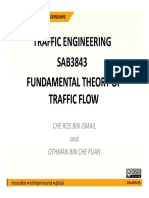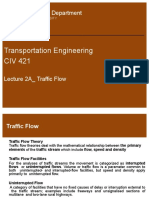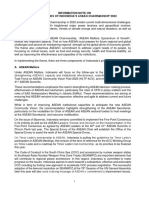Lecture 04 - Traffic Stream Model
Uploaded by
Alyssa Jamille BasilidesLecture 04 - Traffic Stream Model
Uploaded by
Alyssa Jamille BasilidesLecture 04: Traffic Stream Model
I. Types of Flow
• Uninterrupted Flow – vehicles are not required to stop by any cause external
to the traffic stream
• Interrupted Flow – vehicles are required to stop by cause outside the traffic
stream, such as traffic sign or signal (usually at an intersection)
Uninterrupted flow can be described using any of the following traffic variables:
- Flow rate or Volume
- Speed
- Density or Concentration
II. Flow Rate or Volume
- Defined as the number of vehicles passing a point during a specified period
of time.
- Often referred to as volume if it is measured over an hour.
𝑁𝑢𝑚𝑏𝑒𝑟 𝑜𝑓 𝑉𝑒ℎ𝑖𝑐𝑙𝑒𝑠 𝑁
𝑞= =
𝑇𝑖𝑚𝑒 𝑇
III. Speed
- Defined as rate of motion in distance per unit of time.
Two Types of Speed:
1. Time Mean Speed
2. Space Mean Speed
• Time Mean Speed
- Also called spot speed, it is simply arithmetic mean of the speeds of
vehicles passing a point within a given interval of time.
- Point is approximated 15-50 m of the road, also known as the trap length.
- Individual speed of the vehicles (ui) is computed by dividing the trap length
by the measured time.
- Often used as basis for establishing speed limits.
∑𝑛𝑖=1 𝜇𝑖
𝜇𝑡 =
𝑛
• Space Mean Speed
- Used to describe the rate of movement of a traffic stream within a given
section of road.
- It is the speed based on the average travel time of vehicles in the stream
within the section.
- Also called as harmonic mean speed.
𝑑𝑖𝑠𝑡𝑎𝑛𝑐𝑒 𝑡𝑟𝑎𝑣𝑒𝑙𝑙𝑒𝑑 𝑑 𝑛
𝜇𝑠 = = 𝑛 =
𝑎𝑣𝑒𝑟𝑎𝑔𝑒 𝑡𝑟𝑎𝑣𝑒𝑙 𝑡𝑖𝑚𝑒 ∑𝑖=1 𝑡𝑖 ∑𝑛 1
𝑖=1 𝜇
𝑛 𝑖
IV. Density
- Defined as the number of vehicles in a given length of road at an instant
point in time.
- The number of vehicles counted at time t divided by the length of the
section L gives a measure of density in that section.
𝑁𝑢𝑚𝑏𝑒𝑟 𝑜𝑓 𝑉𝑒ℎ𝑖𝑐𝑙𝑒𝑠 𝑛
𝑘= =
𝐿𝑒𝑛𝑔𝑡ℎ 𝑜𝑓 𝑅𝑜𝑎𝑑 𝐿
V. Relationship of 3 Major Variables:
• Traffic Stream Model – relationship among the three variables u, k and q.
• Flow rate (veh/hr) is simply the product of density (veh/km) and space mean speed
(km/hr)
𝑞 = 𝑘 × 𝜇𝑠
Example 1: In an observation post shows that 5 vehicles pass through the post
at intervals of 8 sec, 9 sec, 10 sec, 11 sec and 13 sec, respectively. The speeds of the
vehicles were 80 kph, 76 kph, 70 kph, 60 kph and 50 kph, respectively.
a. Compute the time mean speed.
b. Compute the space mean speed if the distance traveled by the vehicles is 250 m.
c. If the density of traffic is 20 vehicles per km, compute the rate of flow of traffic in
vehicles/hour.
Example 2: From the data of a highway traffic observation team, shows the
distances each vehicle has traveled every 3 seconds on a portion of the highway.
Vehicle Distance
1 88 m
2 86 m
3 83 m
4 82 m
a. Compute the space mean speed of the traffic.
b. Compute the flow of traffic.
c. Compute the density of traffic.
VI. Daily Volumes
Daily volumes are frequently used as the basis for highway planning, for general
trend observations, as well as for traffic volume projections. Four daily volume
parameters are widely used: average annual daily traffic (AADT), average annual
weekday traffic (AAWT), average daily traffic (ADT), and average weekday traffic
(AWT). The unit describing all these volumes is vehicles per day (veh/ day).
VII. Hourly Volumes
Hourly volumes are designed to reflect the variation of traffic over the different
time period of a day. They are also used to identify single hour or period of highest
volume in a day occurring during the morning and evening commute, that is, rush
hours. The single hour of the day corresponding to the highest hourly volume is
referred to as peak hour. The peak hour traffic volume is a critical input in the design
and operational analysis of transportation facilities. The peak hour volume is usually a
directional traffic, that is, the direction of flows is separated. Highway design as well
as other operations analysis, such as signal design, must adequately serve the peak-
hour flow corresponding to the peak direction.
Peak hour volumes can sometimes be estimated from AADT, as follows:
DDHV = AADT x K x D
where DDHV = directional design hourly volume (veh/ hr)
AADT = average annual daily traffic (24 hours) (veh/day)
K = factor for proportion of daily traffic occurring at peak hour
D = factor for proportion of traffic in peak direction
Example 3: Consider a two-lane rural highway with an AADT of 20,000 vehicles per day.
Assume a design hour factor (K) of 0.15 and a directional distribution factor (D) of 0.60.
DDHV = AADT x K x D
DDHV = 20,000 * 0.15 * 0.60 = 1,800 vehicles per hour per direction
This means that during the peak hour, a maximum of 1,800 vehicles are expected to travel
in the peak direction on this highway.
VIII. Sub-hourly Volumes
Sub-hourly volumes represent traffic variation within the peak hour ,i.e., short-term
fluctuations in traffic demand. In fact, a facility design may be adequate for design hour,
but breakdown may occur due to short-term fluctuations. Typical designs and operational
analyses are based on 15-minute peak traffic within the peak hour (e.g., level of service
analysis using Highway Capacity Manual).
The peak-hour factor (PHF) is calculated to relate the peak flow rate to hourly volumes.
This relationship is estimated as follows:
𝑉
PHF =
4×𝑉15
Where PHF = peak hour factor
V = peak hour volume (veh/hr)
V15 = volume for peak 15-min period (veh)
The PHF describes trip-generation characteristics. When PHF is known, it can be
used to
convert a peak-hour volume to an estimated peak rate of flow within an hour:
𝑉
𝑣=
𝑃𝐻𝐹
where 𝑣 = peak rate of flow within hour (veh/ hr)
V = peak hourly volume (veh/ hr)
PHF = peak hour factor
Example 4: A traffic volume study was conducted at a specific intersection. The following
traffic volumes were recorded for each 15-minute interval during the peak hour:
Time Interval Volume (vehicles)
4:00-4:15 300
4:15-4:30 450
4:30-4:45 350
4:45-5:00 250
a. Calculate the Peak Hour Factor (PHF) for this intersection.
b. Calculate the peak rate of flow within the hour (vehicles per hour).
Solution:
a.
1. Identify the Peak 15-Minute Volume:
- The peak 15-minute volume is 450 vehicles.
2. Calculate the Total Hourly Volume:
- Total Hourly Volume = 300 + 450 + 350 + 250 = 1350 vehicles
3. Calculate the PHF:
PHF = (Total Hourly Volume) / (4 * Peak 15-Minute Volume)
PHF = 1350 / (4 * 450)
PHF = 0.75
Interpretation:
A PHF of 0.75 indicates that the traffic flow during the peak hour was not evenly
distributed. In other words, a significant portion of the traffic volume was concentrated
in the peak 15-minute period.
Note:
- A higher PHF value (closer to 1) indicates a more evenly distributed flow.
- A lower PHF value indicates a more concentrated flow.
- PHF is a crucial parameter in traffic engineering as it helps in designing
traffic signals, estimating capacity, and analyzing traffic operations.
b.
𝑉
𝑣=
𝑃𝐻𝐹
1350
𝑣=
0.75
𝑣 = 1,800
The peak rate of flow within the hour is 1800 vehicles per hour. This means that
during the peak 15-minute period, traffic was flowing at a rate of 1800 vehicles per
hour.
IX. Spacing of Vehicles
𝑉𝑜𝑙𝑢𝑚𝑒 𝑜𝑓 𝑡𝑟𝑎𝑓𝑓𝑖𝑐 𝑖𝑛 𝑣𝑒ℎ𝑖𝑐𝑙𝑒𝑠/ℎ𝑜𝑢𝑟
𝑁𝑜. 𝑜𝑓 𝑉𝑒ℎ𝑖𝑐𝑙𝑒𝑠 𝑝𝑒𝑟 𝑘𝑚 =
𝐴𝑣𝑒𝑟𝑎𝑔𝑒 𝑆𝑝𝑒𝑒𝑑 𝑜𝑓 𝑐𝑎𝑟 𝑖𝑛 𝑘𝑚/ℎ𝑟
𝐴𝑣𝑒𝑟𝑎𝑔𝑒 𝑑𝑒𝑛𝑠𝑖𝑡𝑦 = 𝑁𝑜. 𝑜𝑓 𝑣𝑒ℎ𝑖𝑐𝑙𝑒𝑠 𝑝𝑒𝑟 𝑘𝑚
1000
𝑆𝑝𝑎𝑐𝑖𝑛𝑔 𝑜𝑓 𝑉𝑒ℎ𝑖𝑐𝑙𝑒𝑠 =
𝑎𝑣𝑒𝑟𝑎𝑔𝑒 𝑑𝑒𝑛𝑠𝑖𝑡𝑦
Note: 1km = 1000m
X. Capacity of a Single Lane
𝑆 = 𝑉𝑡 + 𝐿
1000(𝑉)
𝐶=
𝑆
S = average center to center spacing of cars in meters
V = average speed of cars in meters
t = reaction time in seconds
L = Length of one car in meters
C = Capacity of a single lane in vehicles/hour
Example 5: Determine the approximate spacing of vehicles center to center in a certain
lane if the average speed of the cars using that particular lane is 40 kph and the
volume of traffic is 800 vehicles per hour.
Example 6: The speed of a car moving on a single lane is 60 kph. If the length of the
is 4.2 m and the value of the reaction time is 0.7 sec,
a. Compute the average center to center of cars in meter.
b. Compute the capacity of the single lane in vehicles per hour.
c. Average density in vehicles/km.
You might also like
- Transportation Engineering: Traffic CharacteristicsNo ratings yetTransportation Engineering: Traffic Characteristics24 pages
- 2020 Fundamental Theory of Traffic FlowNo ratings yet2020 Fundamental Theory of Traffic Flow79 pages
- 01 - Traffic Stream Characteristics (120809)No ratings yet01 - Traffic Stream Characteristics (120809)63 pages
- Traffic System Components & Fundamental Theory of Traffic FlowNo ratings yetTraffic System Components & Fundamental Theory of Traffic Flow39 pages
- CETB 4013 - Traffic Flow Characteristic 4No ratings yetCETB 4013 - Traffic Flow Characteristic 443 pages
- Transportation Engineering - I: Traffic Flow CharacteristicsNo ratings yetTransportation Engineering - I: Traffic Flow Characteristics43 pages
- Traffic System Components & Fundamental Theory of Traffic FlowNo ratings yetTraffic System Components & Fundamental Theory of Traffic Flow7 pages
- CE 447 Traffic Engineering_Traffic Flow_Lec_4No ratings yetCE 447 Traffic Engineering_Traffic Flow_Lec_444 pages
- Highway LAB: Experiment No.1 Traffic VolumeNo ratings yetHighway LAB: Experiment No.1 Traffic Volume10 pages
- Traffic Stream Characteristics: 1. ObjectiveNo ratings yetTraffic Stream Characteristics: 1. Objective36 pages
- Transportation Engineering-Traffic EngineeringNo ratings yetTransportation Engineering-Traffic Engineering46 pages
- Automated Fare Collection System & Urban Public Transportation: An Economic & Management Approach To Urban Transit SystemsFrom EverandAutomated Fare Collection System & Urban Public Transportation: An Economic & Management Approach To Urban Transit SystemsNo ratings yet
- Aims and Objectives - What's The Difference?: June 9, 2014 Pat ThomsonNo ratings yetAims and Objectives - What's The Difference?: June 9, 2014 Pat Thomson2 pages
- BE IV Sem Hall Tickets Dec 2020-Pages-80-211No ratings yetBE IV Sem Hall Tickets Dec 2020-Pages-80-211132 pages
- Research Methodology: Qudrattullah OmerkhelNo ratings yetResearch Methodology: Qudrattullah Omerkhel99 pages
- tc1972en-ed05_limits_and_dimensioning_for_omnipcx_office_rce_release_10.3No ratings yettc1972en-ed05_limits_and_dimensioning_for_omnipcx_office_rce_release_10.316 pages
- Applications of Thin Airfoil Theory - Part 1No ratings yetApplications of Thin Airfoil Theory - Part 128 pages
- Information Note On Indonesia's ASEAN Chairmanship Priorities - As of 3 Feb 2023No ratings yetInformation Note On Indonesia's ASEAN Chairmanship Priorities - As of 3 Feb 20234 pages
- Mental Models: An Interdisciplinary Synthesis of Theory and MethodsNo ratings yetMental Models: An Interdisciplinary Synthesis of Theory and Methods13 pages
- Transportation Engineering: Traffic CharacteristicsTransportation Engineering: Traffic Characteristics
- Traffic System Components & Fundamental Theory of Traffic FlowTraffic System Components & Fundamental Theory of Traffic Flow
- Transportation Engineering - I: Traffic Flow CharacteristicsTransportation Engineering - I: Traffic Flow Characteristics
- Traffic System Components & Fundamental Theory of Traffic FlowTraffic System Components & Fundamental Theory of Traffic Flow
- Automated Fare Collection System & Urban Public Transportation: An Economic & Management Approach To Urban Transit SystemsFrom EverandAutomated Fare Collection System & Urban Public Transportation: An Economic & Management Approach To Urban Transit Systems
- Aims and Objectives - What's The Difference?: June 9, 2014 Pat ThomsonAims and Objectives - What's The Difference?: June 9, 2014 Pat Thomson
- tc1972en-ed05_limits_and_dimensioning_for_omnipcx_office_rce_release_10.3tc1972en-ed05_limits_and_dimensioning_for_omnipcx_office_rce_release_10.3
- Information Note On Indonesia's ASEAN Chairmanship Priorities - As of 3 Feb 2023Information Note On Indonesia's ASEAN Chairmanship Priorities - As of 3 Feb 2023
- Mental Models: An Interdisciplinary Synthesis of Theory and MethodsMental Models: An Interdisciplinary Synthesis of Theory and Methods

























































































